Analyzing Liquidation: Liabilities, Ethics & Governance in Accounting
VerifiedAdded on 2023/06/07
|8
|2936
|340
Report
AI Summary
This report analyzes the liquidation of ABC Learning, HIH Insurance, and One Tel, identifying key factors such as debt accumulation, unethical practices, and governance failures. ABC Learning's downfall was due to excessive debt and overstated asset values, while HIH Insurance suffered from insuring high-risk businesses and accounting rule changes. One Tel overstated profits by reducing expenses unethically. The report emphasizes the importance of ethical conduct, adherence to accounting standards, and responsible liability management in preventing organizational collapse. Ethical codes like integrity, confidentiality, and professional conduct are crucial for accountants. Rising liabilities played a significant role in the demise of these companies, highlighting the need for sustainable financial practices. Desklib provides access to similar solved assignments for students.
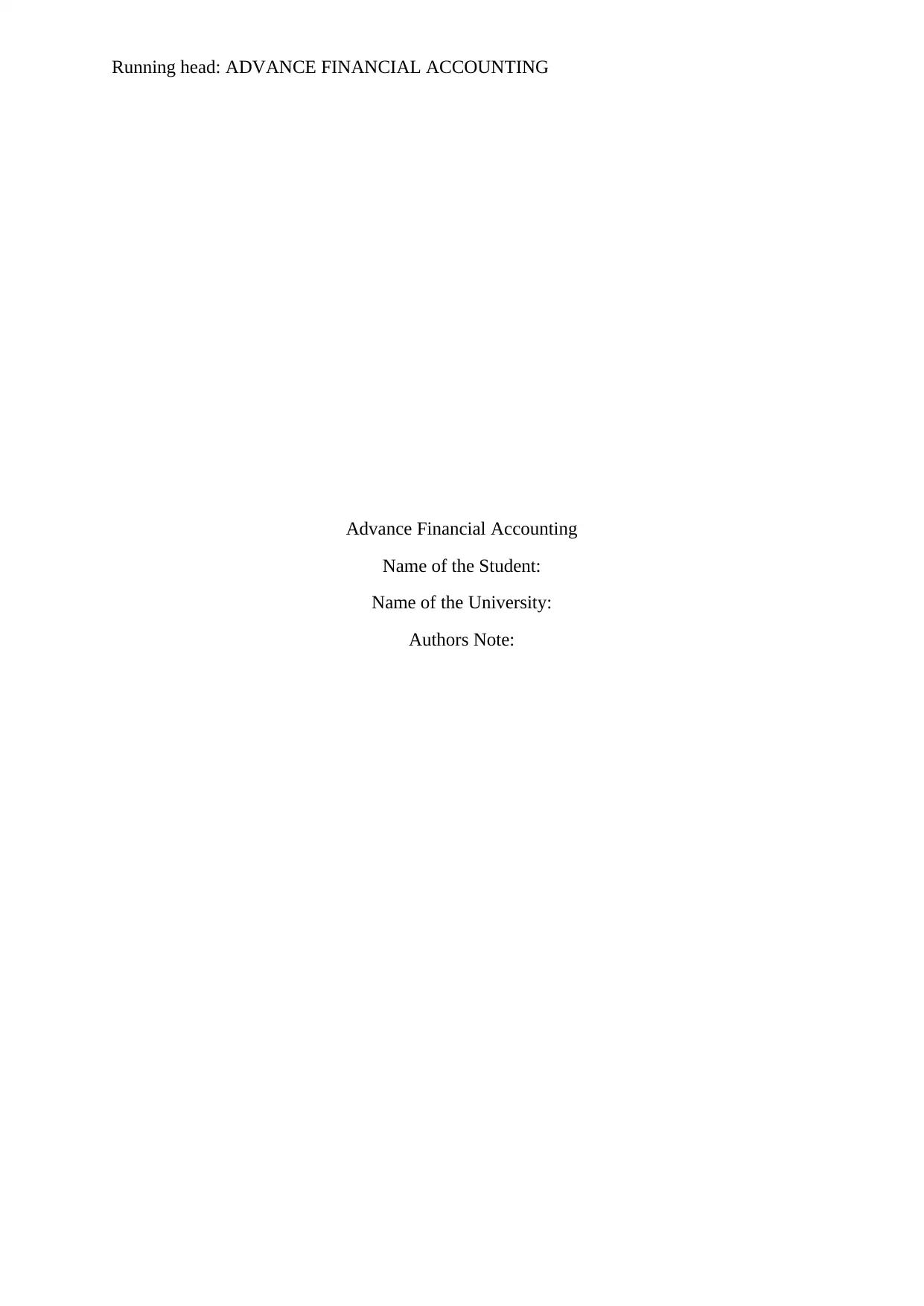
Running head: ADVANCE FINANCIAL ACCOUNTING
Advance Financial Accounting
Name of the Student:
Name of the University:
Authors Note:
Advance Financial Accounting
Name of the Student:
Name of the University:
Authors Note:
Paraphrase This Document
Need a fresh take? Get an instant paraphrase of this document with our AI Paraphraser
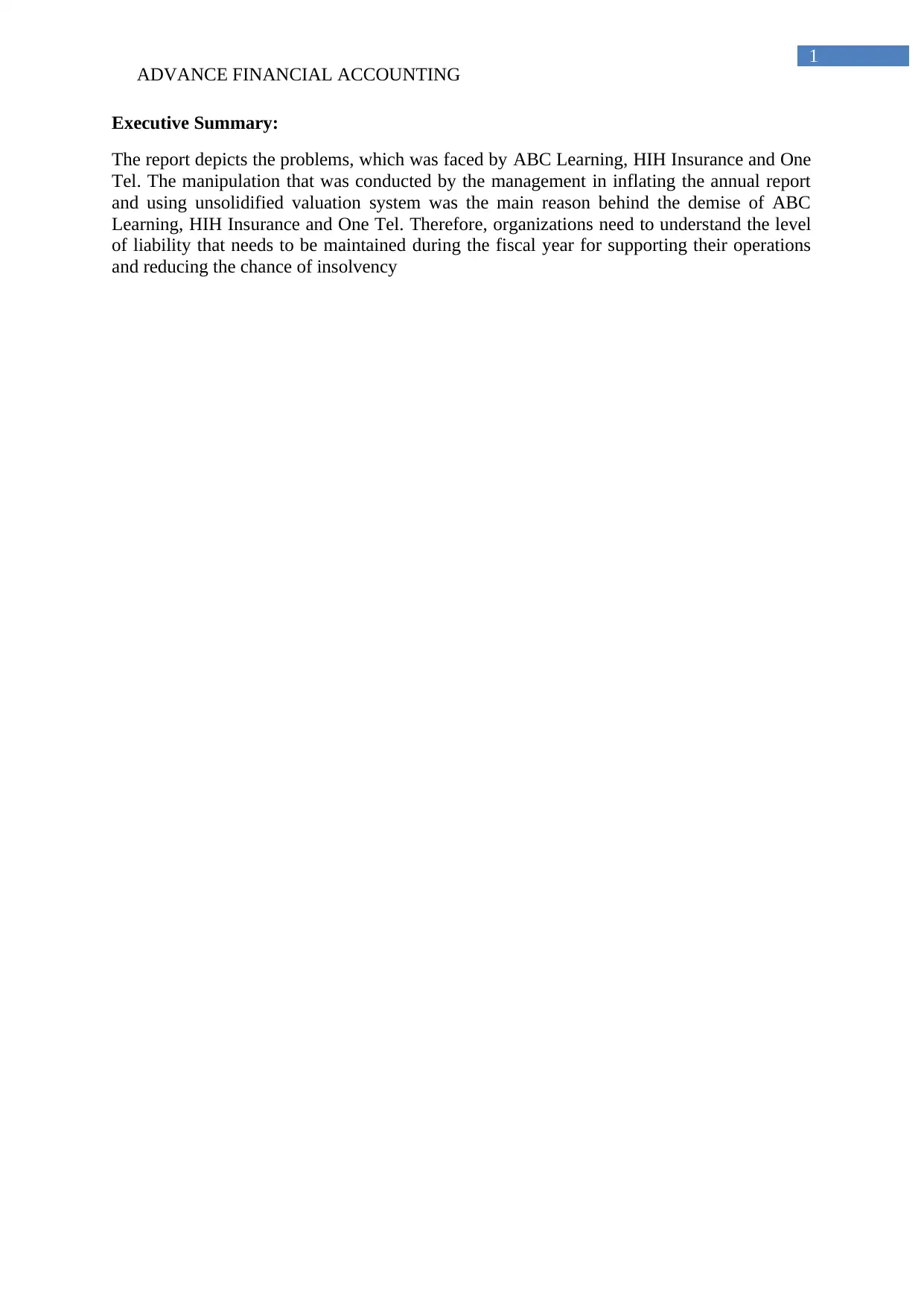
ADVANCE FINANCIAL ACCOUNTING 1
Executive Summary:
The report depicts the problems, which was faced by ABC Learning, HIH Insurance and One
Tel. The manipulation that was conducted by the management in inflating the annual report
and using unsolidified valuation system was the main reason behind the demise of ABC
Learning, HIH Insurance and One Tel. Therefore, organizations need to understand the level
of liability that needs to be maintained during the fiscal year for supporting their operations
and reducing the chance of insolvency
Executive Summary:
The report depicts the problems, which was faced by ABC Learning, HIH Insurance and One
Tel. The manipulation that was conducted by the management in inflating the annual report
and using unsolidified valuation system was the main reason behind the demise of ABC
Learning, HIH Insurance and One Tel. Therefore, organizations need to understand the level
of liability that needs to be maintained during the fiscal year for supporting their operations
and reducing the chance of insolvency
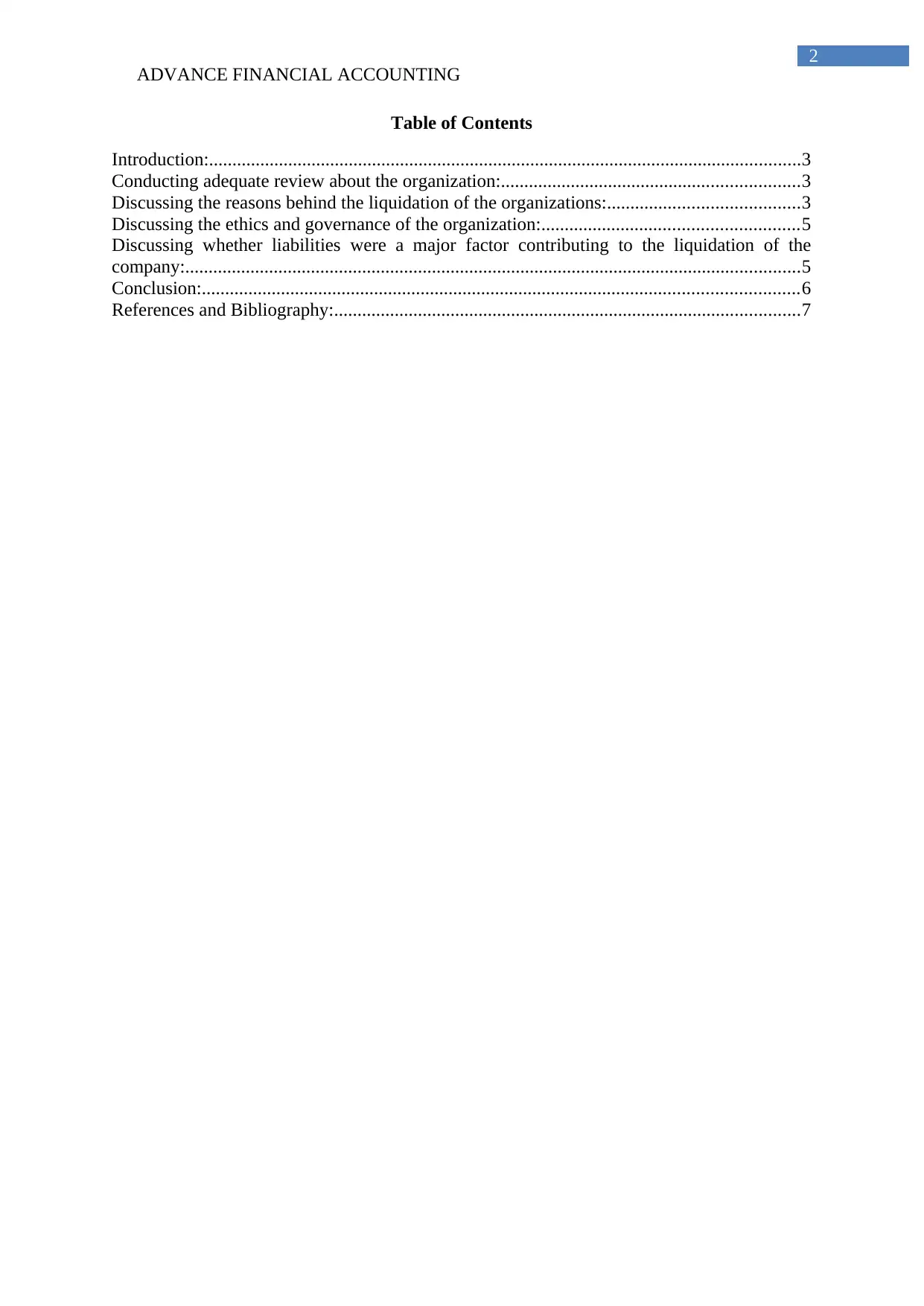
ADVANCE FINANCIAL ACCOUNTING 2
Table of Contents
Introduction:...............................................................................................................................3
Conducting adequate review about the organization:................................................................3
Discussing the reasons behind the liquidation of the organizations:.........................................3
Discussing the ethics and governance of the organization:.......................................................5
Discussing whether liabilities were a major factor contributing to the liquidation of the
company:....................................................................................................................................5
Conclusion:................................................................................................................................6
References and Bibliography:....................................................................................................7
Table of Contents
Introduction:...............................................................................................................................3
Conducting adequate review about the organization:................................................................3
Discussing the reasons behind the liquidation of the organizations:.........................................3
Discussing the ethics and governance of the organization:.......................................................5
Discussing whether liabilities were a major factor contributing to the liquidation of the
company:....................................................................................................................................5
Conclusion:................................................................................................................................6
References and Bibliography:....................................................................................................7
⊘ This is a preview!⊘
Do you want full access?
Subscribe today to unlock all pages.

Trusted by 1+ million students worldwide
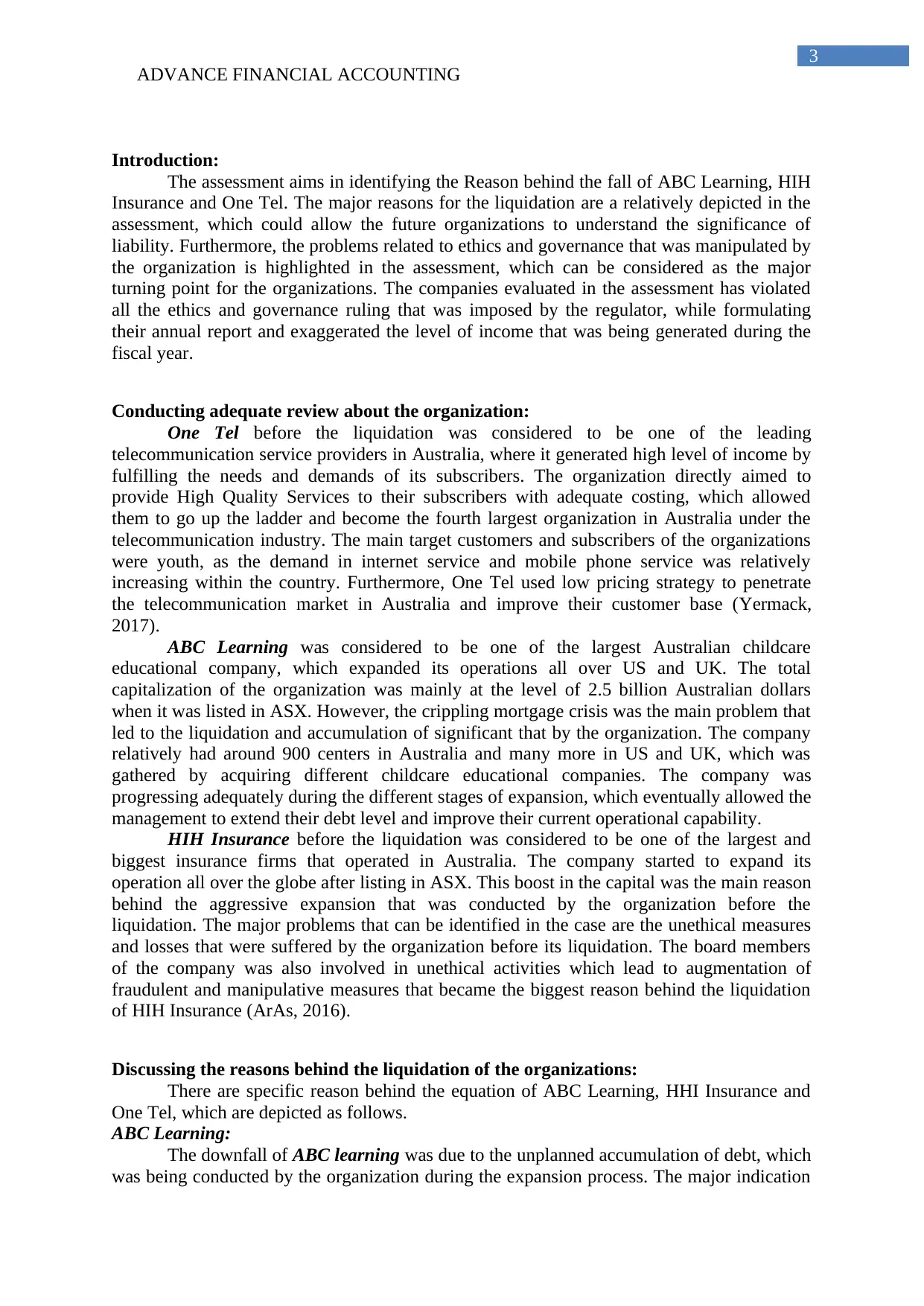
ADVANCE FINANCIAL ACCOUNTING 3
Introduction:
The assessment aims in identifying the Reason behind the fall of ABC Learning, HIH
Insurance and One Tel. The major reasons for the liquidation are a relatively depicted in the
assessment, which could allow the future organizations to understand the significance of
liability. Furthermore, the problems related to ethics and governance that was manipulated by
the organization is highlighted in the assessment, which can be considered as the major
turning point for the organizations. The companies evaluated in the assessment has violated
all the ethics and governance ruling that was imposed by the regulator, while formulating
their annual report and exaggerated the level of income that was being generated during the
fiscal year.
Conducting adequate review about the organization:
One Tel before the liquidation was considered to be one of the leading
telecommunication service providers in Australia, where it generated high level of income by
fulfilling the needs and demands of its subscribers. The organization directly aimed to
provide High Quality Services to their subscribers with adequate costing, which allowed
them to go up the ladder and become the fourth largest organization in Australia under the
telecommunication industry. The main target customers and subscribers of the organizations
were youth, as the demand in internet service and mobile phone service was relatively
increasing within the country. Furthermore, One Tel used low pricing strategy to penetrate
the telecommunication market in Australia and improve their customer base (Yermack,
2017).
ABC Learning was considered to be one of the largest Australian childcare
educational company, which expanded its operations all over US and UK. The total
capitalization of the organization was mainly at the level of 2.5 billion Australian dollars
when it was listed in ASX. However, the crippling mortgage crisis was the main problem that
led to the liquidation and accumulation of significant that by the organization. The company
relatively had around 900 centers in Australia and many more in US and UK, which was
gathered by acquiring different childcare educational companies. The company was
progressing adequately during the different stages of expansion, which eventually allowed the
management to extend their debt level and improve their current operational capability.
HIH Insurance before the liquidation was considered to be one of the largest and
biggest insurance firms that operated in Australia. The company started to expand its
operation all over the globe after listing in ASX. This boost in the capital was the main reason
behind the aggressive expansion that was conducted by the organization before the
liquidation. The major problems that can be identified in the case are the unethical measures
and losses that were suffered by the organization before its liquidation. The board members
of the company was also involved in unethical activities which lead to augmentation of
fraudulent and manipulative measures that became the biggest reason behind the liquidation
of HIH Insurance (ArAs, 2016).
Discussing the reasons behind the liquidation of the organizations:
There are specific reason behind the equation of ABC Learning, HHI Insurance and
One Tel, which are depicted as follows.
ABC Learning:
The downfall of ABC learning was due to the unplanned accumulation of debt, which
was being conducted by the organization during the expansion process. The major indication
Introduction:
The assessment aims in identifying the Reason behind the fall of ABC Learning, HIH
Insurance and One Tel. The major reasons for the liquidation are a relatively depicted in the
assessment, which could allow the future organizations to understand the significance of
liability. Furthermore, the problems related to ethics and governance that was manipulated by
the organization is highlighted in the assessment, which can be considered as the major
turning point for the organizations. The companies evaluated in the assessment has violated
all the ethics and governance ruling that was imposed by the regulator, while formulating
their annual report and exaggerated the level of income that was being generated during the
fiscal year.
Conducting adequate review about the organization:
One Tel before the liquidation was considered to be one of the leading
telecommunication service providers in Australia, where it generated high level of income by
fulfilling the needs and demands of its subscribers. The organization directly aimed to
provide High Quality Services to their subscribers with adequate costing, which allowed
them to go up the ladder and become the fourth largest organization in Australia under the
telecommunication industry. The main target customers and subscribers of the organizations
were youth, as the demand in internet service and mobile phone service was relatively
increasing within the country. Furthermore, One Tel used low pricing strategy to penetrate
the telecommunication market in Australia and improve their customer base (Yermack,
2017).
ABC Learning was considered to be one of the largest Australian childcare
educational company, which expanded its operations all over US and UK. The total
capitalization of the organization was mainly at the level of 2.5 billion Australian dollars
when it was listed in ASX. However, the crippling mortgage crisis was the main problem that
led to the liquidation and accumulation of significant that by the organization. The company
relatively had around 900 centers in Australia and many more in US and UK, which was
gathered by acquiring different childcare educational companies. The company was
progressing adequately during the different stages of expansion, which eventually allowed the
management to extend their debt level and improve their current operational capability.
HIH Insurance before the liquidation was considered to be one of the largest and
biggest insurance firms that operated in Australia. The company started to expand its
operation all over the globe after listing in ASX. This boost in the capital was the main reason
behind the aggressive expansion that was conducted by the organization before the
liquidation. The major problems that can be identified in the case are the unethical measures
and losses that were suffered by the organization before its liquidation. The board members
of the company was also involved in unethical activities which lead to augmentation of
fraudulent and manipulative measures that became the biggest reason behind the liquidation
of HIH Insurance (ArAs, 2016).
Discussing the reasons behind the liquidation of the organizations:
There are specific reason behind the equation of ABC Learning, HHI Insurance and
One Tel, which are depicted as follows.
ABC Learning:
The downfall of ABC learning was due to the unplanned accumulation of debt, which
was being conducted by the organization during the expansion process. The major indication
Paraphrase This Document
Need a fresh take? Get an instant paraphrase of this document with our AI Paraphraser
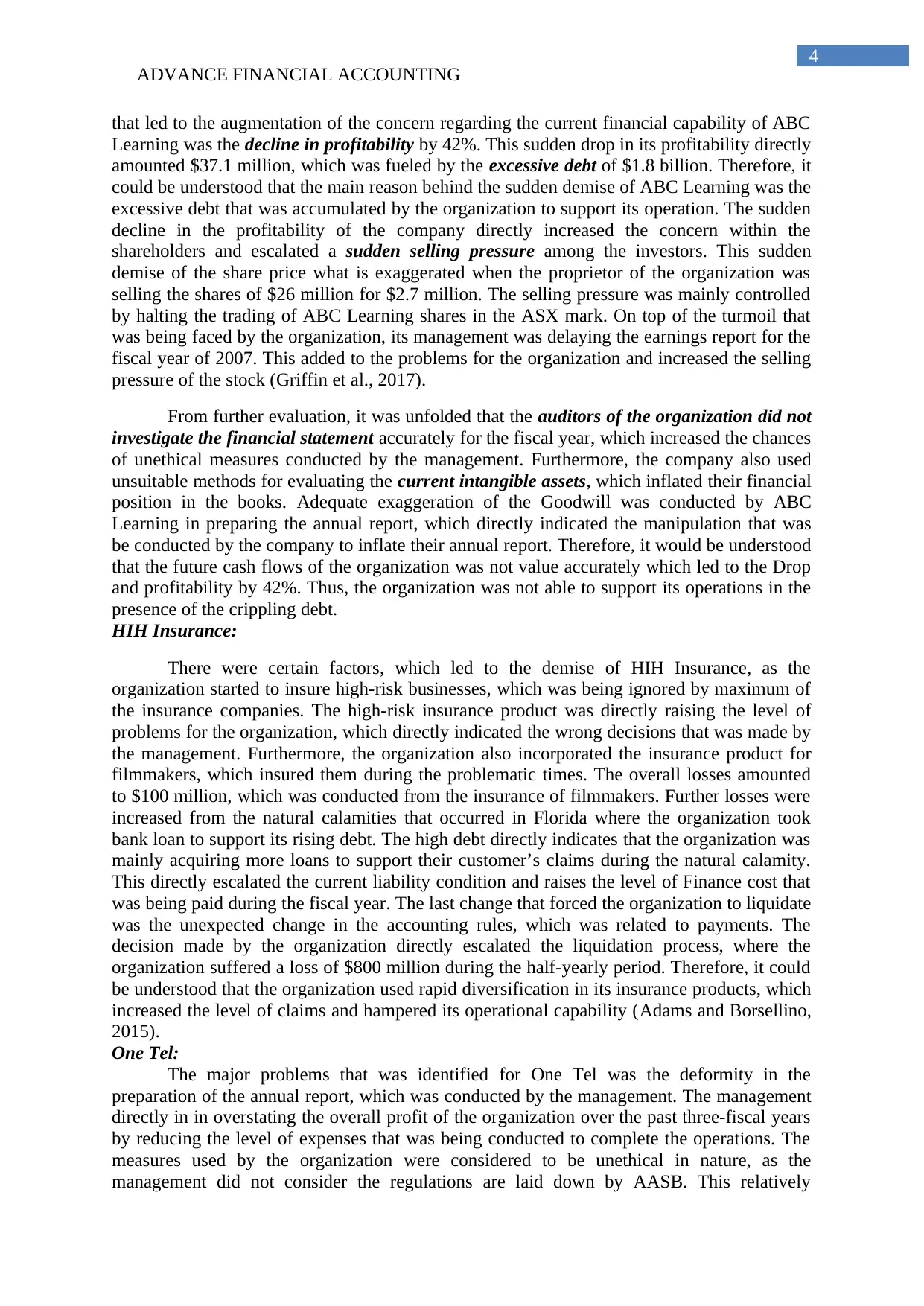
ADVANCE FINANCIAL ACCOUNTING 4
that led to the augmentation of the concern regarding the current financial capability of ABC
Learning was the decline in profitability by 42%. This sudden drop in its profitability directly
amounted $37.1 million, which was fueled by the excessive debt of $1.8 billion. Therefore, it
could be understood that the main reason behind the sudden demise of ABC Learning was the
excessive debt that was accumulated by the organization to support its operation. The sudden
decline in the profitability of the company directly increased the concern within the
shareholders and escalated a sudden selling pressure among the investors. This sudden
demise of the share price what is exaggerated when the proprietor of the organization was
selling the shares of $26 million for $2.7 million. The selling pressure was mainly controlled
by halting the trading of ABC Learning shares in the ASX mark. On top of the turmoil that
was being faced by the organization, its management was delaying the earnings report for the
fiscal year of 2007. This added to the problems for the organization and increased the selling
pressure of the stock (Griffin et al., 2017).
From further evaluation, it was unfolded that the auditors of the organization did not
investigate the financial statement accurately for the fiscal year, which increased the chances
of unethical measures conducted by the management. Furthermore, the company also used
unsuitable methods for evaluating the current intangible assets, which inflated their financial
position in the books. Adequate exaggeration of the Goodwill was conducted by ABC
Learning in preparing the annual report, which directly indicated the manipulation that was
be conducted by the company to inflate their annual report. Therefore, it would be understood
that the future cash flows of the organization was not value accurately which led to the Drop
and profitability by 42%. Thus, the organization was not able to support its operations in the
presence of the crippling debt.
HIH Insurance:
There were certain factors, which led to the demise of HIH Insurance, as the
organization started to insure high-risk businesses, which was being ignored by maximum of
the insurance companies. The high-risk insurance product was directly raising the level of
problems for the organization, which directly indicated the wrong decisions that was made by
the management. Furthermore, the organization also incorporated the insurance product for
filmmakers, which insured them during the problematic times. The overall losses amounted
to $100 million, which was conducted from the insurance of filmmakers. Further losses were
increased from the natural calamities that occurred in Florida where the organization took
bank loan to support its rising debt. The high debt directly indicates that the organization was
mainly acquiring more loans to support their customer’s claims during the natural calamity.
This directly escalated the current liability condition and raises the level of Finance cost that
was being paid during the fiscal year. The last change that forced the organization to liquidate
was the unexpected change in the accounting rules, which was related to payments. The
decision made by the organization directly escalated the liquidation process, where the
organization suffered a loss of $800 million during the half-yearly period. Therefore, it could
be understood that the organization used rapid diversification in its insurance products, which
increased the level of claims and hampered its operational capability (Adams and Borsellino,
2015).
One Tel:
The major problems that was identified for One Tel was the deformity in the
preparation of the annual report, which was conducted by the management. The management
directly in in overstating the overall profit of the organization over the past three-fiscal years
by reducing the level of expenses that was being conducted to complete the operations. The
measures used by the organization were considered to be unethical in nature, as the
management did not consider the regulations are laid down by AASB. This relatively
that led to the augmentation of the concern regarding the current financial capability of ABC
Learning was the decline in profitability by 42%. This sudden drop in its profitability directly
amounted $37.1 million, which was fueled by the excessive debt of $1.8 billion. Therefore, it
could be understood that the main reason behind the sudden demise of ABC Learning was the
excessive debt that was accumulated by the organization to support its operation. The sudden
decline in the profitability of the company directly increased the concern within the
shareholders and escalated a sudden selling pressure among the investors. This sudden
demise of the share price what is exaggerated when the proprietor of the organization was
selling the shares of $26 million for $2.7 million. The selling pressure was mainly controlled
by halting the trading of ABC Learning shares in the ASX mark. On top of the turmoil that
was being faced by the organization, its management was delaying the earnings report for the
fiscal year of 2007. This added to the problems for the organization and increased the selling
pressure of the stock (Griffin et al., 2017).
From further evaluation, it was unfolded that the auditors of the organization did not
investigate the financial statement accurately for the fiscal year, which increased the chances
of unethical measures conducted by the management. Furthermore, the company also used
unsuitable methods for evaluating the current intangible assets, which inflated their financial
position in the books. Adequate exaggeration of the Goodwill was conducted by ABC
Learning in preparing the annual report, which directly indicated the manipulation that was
be conducted by the company to inflate their annual report. Therefore, it would be understood
that the future cash flows of the organization was not value accurately which led to the Drop
and profitability by 42%. Thus, the organization was not able to support its operations in the
presence of the crippling debt.
HIH Insurance:
There were certain factors, which led to the demise of HIH Insurance, as the
organization started to insure high-risk businesses, which was being ignored by maximum of
the insurance companies. The high-risk insurance product was directly raising the level of
problems for the organization, which directly indicated the wrong decisions that was made by
the management. Furthermore, the organization also incorporated the insurance product for
filmmakers, which insured them during the problematic times. The overall losses amounted
to $100 million, which was conducted from the insurance of filmmakers. Further losses were
increased from the natural calamities that occurred in Florida where the organization took
bank loan to support its rising debt. The high debt directly indicates that the organization was
mainly acquiring more loans to support their customer’s claims during the natural calamity.
This directly escalated the current liability condition and raises the level of Finance cost that
was being paid during the fiscal year. The last change that forced the organization to liquidate
was the unexpected change in the accounting rules, which was related to payments. The
decision made by the organization directly escalated the liquidation process, where the
organization suffered a loss of $800 million during the half-yearly period. Therefore, it could
be understood that the organization used rapid diversification in its insurance products, which
increased the level of claims and hampered its operational capability (Adams and Borsellino,
2015).
One Tel:
The major problems that was identified for One Tel was the deformity in the
preparation of the annual report, which was conducted by the management. The management
directly in in overstating the overall profit of the organization over the past three-fiscal years
by reducing the level of expenses that was being conducted to complete the operations. The
measures used by the organization were considered to be unethical in nature, as the
management did not consider the regulations are laid down by AASB. This relatively
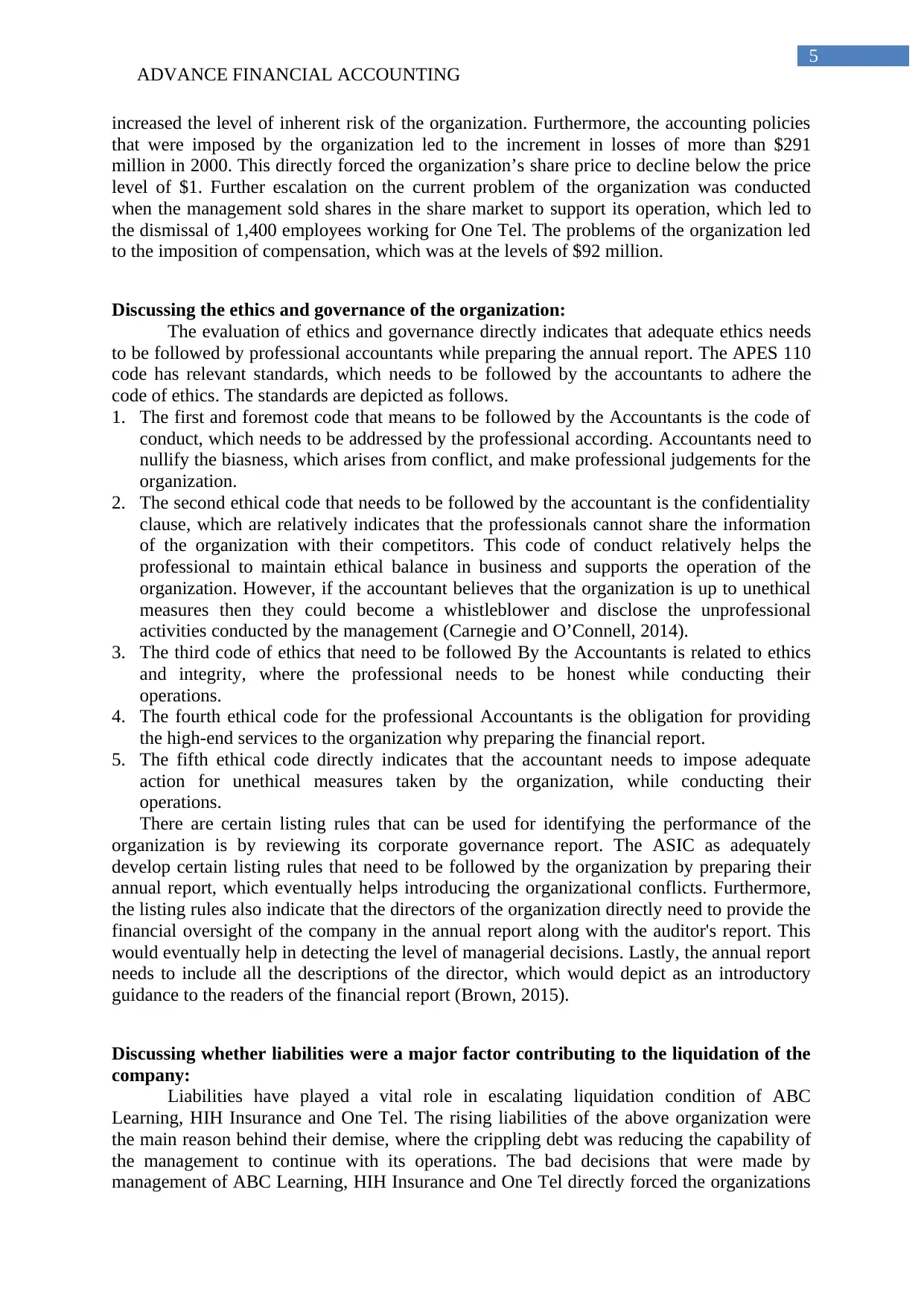
ADVANCE FINANCIAL ACCOUNTING 5
increased the level of inherent risk of the organization. Furthermore, the accounting policies
that were imposed by the organization led to the increment in losses of more than $291
million in 2000. This directly forced the organization’s share price to decline below the price
level of $1. Further escalation on the current problem of the organization was conducted
when the management sold shares in the share market to support its operation, which led to
the dismissal of 1,400 employees working for One Tel. The problems of the organization led
to the imposition of compensation, which was at the levels of $92 million.
Discussing the ethics and governance of the organization:
The evaluation of ethics and governance directly indicates that adequate ethics needs
to be followed by professional accountants while preparing the annual report. The APES 110
code has relevant standards, which needs to be followed by the accountants to adhere the
code of ethics. The standards are depicted as follows.
1. The first and foremost code that means to be followed by the Accountants is the code of
conduct, which needs to be addressed by the professional according. Accountants need to
nullify the biasness, which arises from conflict, and make professional judgements for the
organization.
2. The second ethical code that needs to be followed by the accountant is the confidentiality
clause, which are relatively indicates that the professionals cannot share the information
of the organization with their competitors. This code of conduct relatively helps the
professional to maintain ethical balance in business and supports the operation of the
organization. However, if the accountant believes that the organization is up to unethical
measures then they could become a whistleblower and disclose the unprofessional
activities conducted by the management (Carnegie and O’Connell, 2014).
3. The third code of ethics that need to be followed By the Accountants is related to ethics
and integrity, where the professional needs to be honest while conducting their
operations.
4. The fourth ethical code for the professional Accountants is the obligation for providing
the high-end services to the organization why preparing the financial report.
5. The fifth ethical code directly indicates that the accountant needs to impose adequate
action for unethical measures taken by the organization, while conducting their
operations.
There are certain listing rules that can be used for identifying the performance of the
organization is by reviewing its corporate governance report. The ASIC as adequately
develop certain listing rules that need to be followed by the organization by preparing their
annual report, which eventually helps introducing the organizational conflicts. Furthermore,
the listing rules also indicate that the directors of the organization directly need to provide the
financial oversight of the company in the annual report along with the auditor's report. This
would eventually help in detecting the level of managerial decisions. Lastly, the annual report
needs to include all the descriptions of the director, which would depict as an introductory
guidance to the readers of the financial report (Brown, 2015).
Discussing whether liabilities were a major factor contributing to the liquidation of the
company:
Liabilities have played a vital role in escalating liquidation condition of ABC
Learning, HIH Insurance and One Tel. The rising liabilities of the above organization were
the main reason behind their demise, where the crippling debt was reducing the capability of
the management to continue with its operations. The bad decisions that were made by
management of ABC Learning, HIH Insurance and One Tel directly forced the organizations
increased the level of inherent risk of the organization. Furthermore, the accounting policies
that were imposed by the organization led to the increment in losses of more than $291
million in 2000. This directly forced the organization’s share price to decline below the price
level of $1. Further escalation on the current problem of the organization was conducted
when the management sold shares in the share market to support its operation, which led to
the dismissal of 1,400 employees working for One Tel. The problems of the organization led
to the imposition of compensation, which was at the levels of $92 million.
Discussing the ethics and governance of the organization:
The evaluation of ethics and governance directly indicates that adequate ethics needs
to be followed by professional accountants while preparing the annual report. The APES 110
code has relevant standards, which needs to be followed by the accountants to adhere the
code of ethics. The standards are depicted as follows.
1. The first and foremost code that means to be followed by the Accountants is the code of
conduct, which needs to be addressed by the professional according. Accountants need to
nullify the biasness, which arises from conflict, and make professional judgements for the
organization.
2. The second ethical code that needs to be followed by the accountant is the confidentiality
clause, which are relatively indicates that the professionals cannot share the information
of the organization with their competitors. This code of conduct relatively helps the
professional to maintain ethical balance in business and supports the operation of the
organization. However, if the accountant believes that the organization is up to unethical
measures then they could become a whistleblower and disclose the unprofessional
activities conducted by the management (Carnegie and O’Connell, 2014).
3. The third code of ethics that need to be followed By the Accountants is related to ethics
and integrity, where the professional needs to be honest while conducting their
operations.
4. The fourth ethical code for the professional Accountants is the obligation for providing
the high-end services to the organization why preparing the financial report.
5. The fifth ethical code directly indicates that the accountant needs to impose adequate
action for unethical measures taken by the organization, while conducting their
operations.
There are certain listing rules that can be used for identifying the performance of the
organization is by reviewing its corporate governance report. The ASIC as adequately
develop certain listing rules that need to be followed by the organization by preparing their
annual report, which eventually helps introducing the organizational conflicts. Furthermore,
the listing rules also indicate that the directors of the organization directly need to provide the
financial oversight of the company in the annual report along with the auditor's report. This
would eventually help in detecting the level of managerial decisions. Lastly, the annual report
needs to include all the descriptions of the director, which would depict as an introductory
guidance to the readers of the financial report (Brown, 2015).
Discussing whether liabilities were a major factor contributing to the liquidation of the
company:
Liabilities have played a vital role in escalating liquidation condition of ABC
Learning, HIH Insurance and One Tel. The rising liabilities of the above organization were
the main reason behind their demise, where the crippling debt was reducing the capability of
the management to continue with its operations. The bad decisions that were made by
management of ABC Learning, HIH Insurance and One Tel directly forced the organizations
⊘ This is a preview!⊘
Do you want full access?
Subscribe today to unlock all pages.

Trusted by 1+ million students worldwide
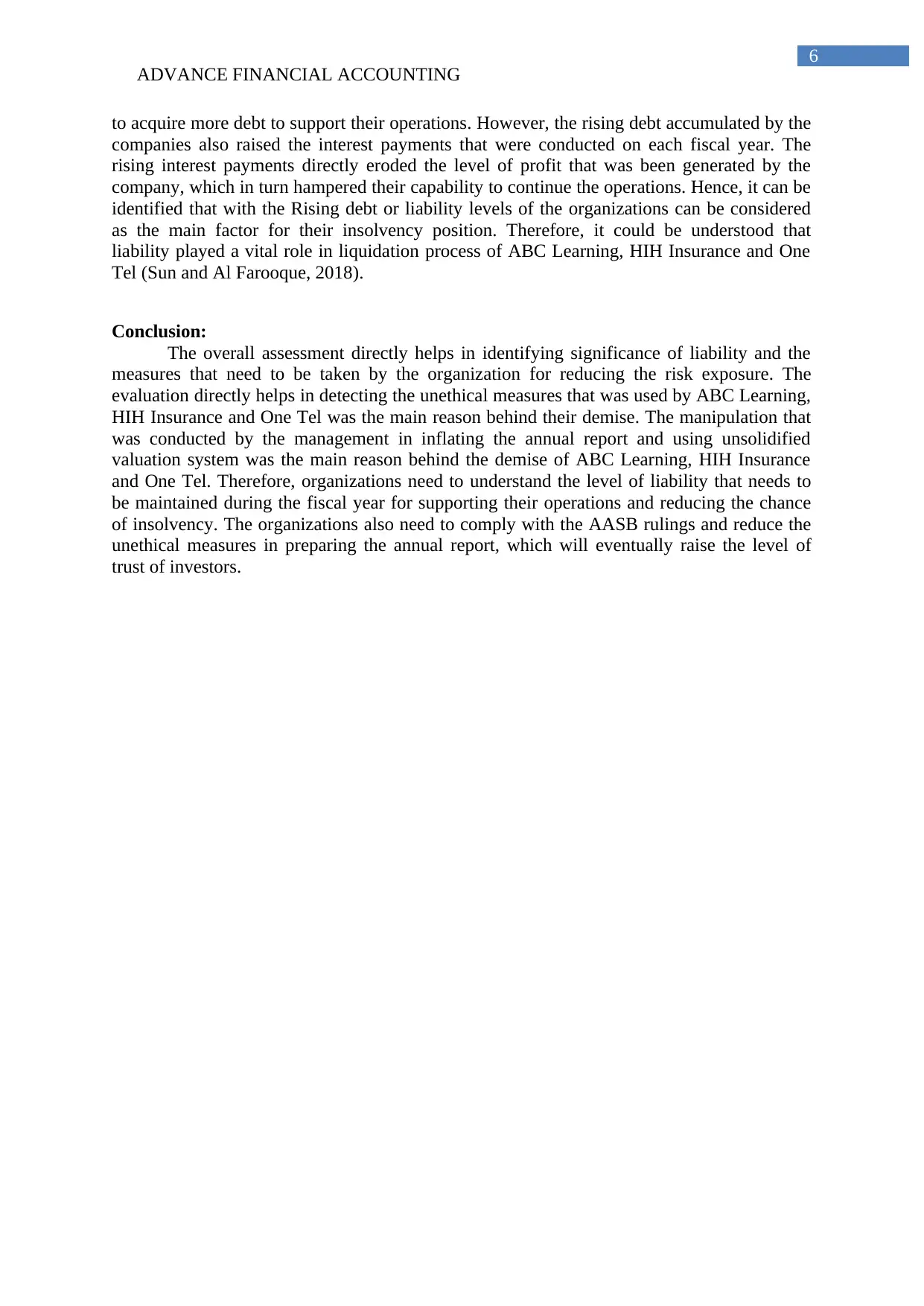
ADVANCE FINANCIAL ACCOUNTING 6
to acquire more debt to support their operations. However, the rising debt accumulated by the
companies also raised the interest payments that were conducted on each fiscal year. The
rising interest payments directly eroded the level of profit that was been generated by the
company, which in turn hampered their capability to continue the operations. Hence, it can be
identified that with the Rising debt or liability levels of the organizations can be considered
as the main factor for their insolvency position. Therefore, it could be understood that
liability played a vital role in liquidation process of ABC Learning, HIH Insurance and One
Tel (Sun and Al Farooque, 2018).
Conclusion:
The overall assessment directly helps in identifying significance of liability and the
measures that need to be taken by the organization for reducing the risk exposure. The
evaluation directly helps in detecting the unethical measures that was used by ABC Learning,
HIH Insurance and One Tel was the main reason behind their demise. The manipulation that
was conducted by the management in inflating the annual report and using unsolidified
valuation system was the main reason behind the demise of ABC Learning, HIH Insurance
and One Tel. Therefore, organizations need to understand the level of liability that needs to
be maintained during the fiscal year for supporting their operations and reducing the chance
of insolvency. The organizations also need to comply with the AASB rulings and reduce the
unethical measures in preparing the annual report, which will eventually raise the level of
trust of investors.
to acquire more debt to support their operations. However, the rising debt accumulated by the
companies also raised the interest payments that were conducted on each fiscal year. The
rising interest payments directly eroded the level of profit that was been generated by the
company, which in turn hampered their capability to continue the operations. Hence, it can be
identified that with the Rising debt or liability levels of the organizations can be considered
as the main factor for their insolvency position. Therefore, it could be understood that
liability played a vital role in liquidation process of ABC Learning, HIH Insurance and One
Tel (Sun and Al Farooque, 2018).
Conclusion:
The overall assessment directly helps in identifying significance of liability and the
measures that need to be taken by the organization for reducing the risk exposure. The
evaluation directly helps in detecting the unethical measures that was used by ABC Learning,
HIH Insurance and One Tel was the main reason behind their demise. The manipulation that
was conducted by the management in inflating the annual report and using unsolidified
valuation system was the main reason behind the demise of ABC Learning, HIH Insurance
and One Tel. Therefore, organizations need to understand the level of liability that needs to
be maintained during the fiscal year for supporting their operations and reducing the chance
of insolvency. The organizations also need to comply with the AASB rulings and reduce the
unethical measures in preparing the annual report, which will eventually raise the level of
trust of investors.
Paraphrase This Document
Need a fresh take? Get an instant paraphrase of this document with our AI Paraphraser
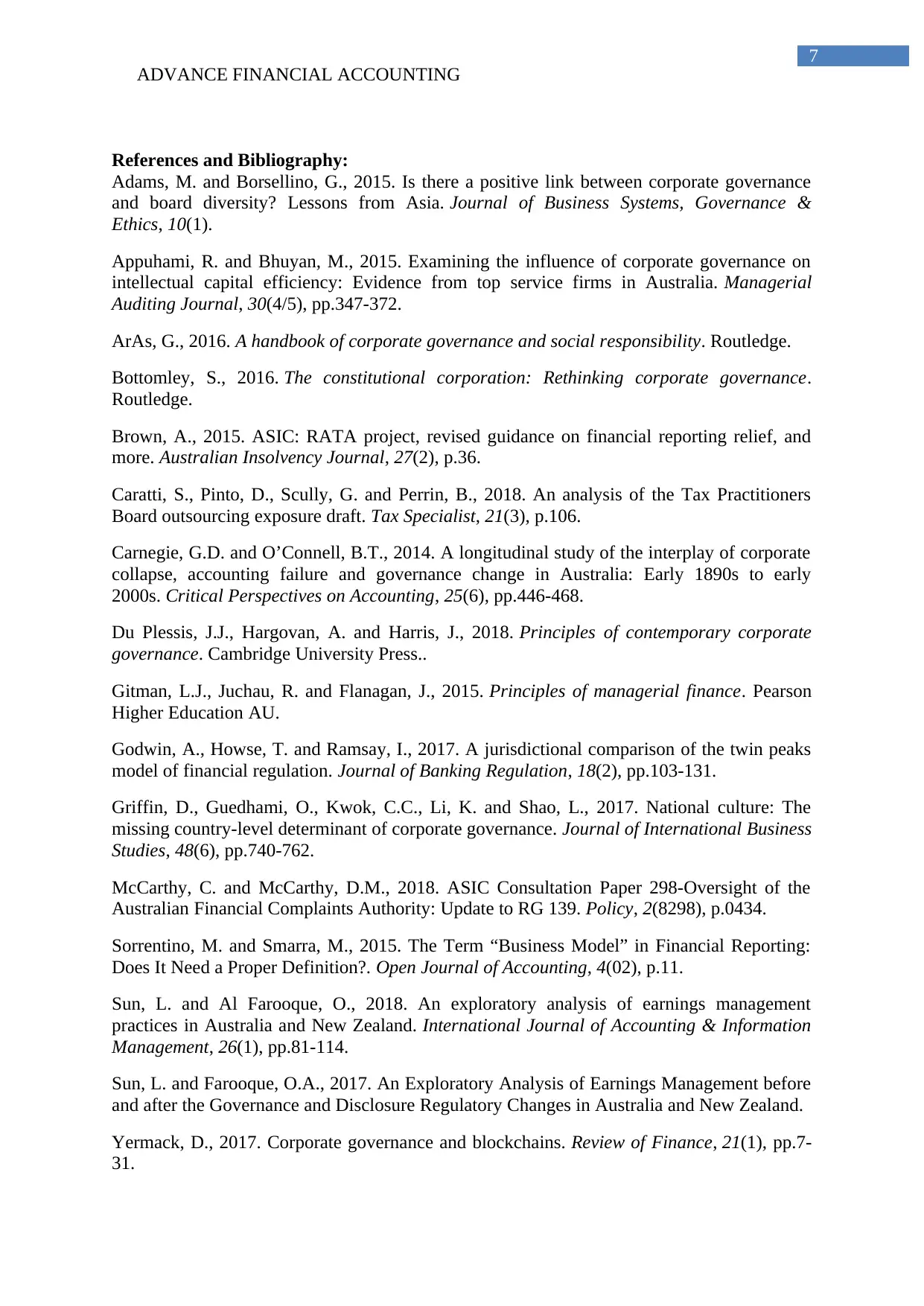
ADVANCE FINANCIAL ACCOUNTING 7
References and Bibliography:
Adams, M. and Borsellino, G., 2015. Is there a positive link between corporate governance
and board diversity? Lessons from Asia. Journal of Business Systems, Governance &
Ethics, 10(1).
Appuhami, R. and Bhuyan, M., 2015. Examining the influence of corporate governance on
intellectual capital efficiency: Evidence from top service firms in Australia. Managerial
Auditing Journal, 30(4/5), pp.347-372.
ArAs, G., 2016. A handbook of corporate governance and social responsibility. Routledge.
Bottomley, S., 2016. The constitutional corporation: Rethinking corporate governance.
Routledge.
Brown, A., 2015. ASIC: RATA project, revised guidance on financial reporting relief, and
more. Australian Insolvency Journal, 27(2), p.36.
Caratti, S., Pinto, D., Scully, G. and Perrin, B., 2018. An analysis of the Tax Practitioners
Board outsourcing exposure draft. Tax Specialist, 21(3), p.106.
Carnegie, G.D. and O’Connell, B.T., 2014. A longitudinal study of the interplay of corporate
collapse, accounting failure and governance change in Australia: Early 1890s to early
2000s. Critical Perspectives on Accounting, 25(6), pp.446-468.
Du Plessis, J.J., Hargovan, A. and Harris, J., 2018. Principles of contemporary corporate
governance. Cambridge University Press..
Gitman, L.J., Juchau, R. and Flanagan, J., 2015. Principles of managerial finance. Pearson
Higher Education AU.
Godwin, A., Howse, T. and Ramsay, I., 2017. A jurisdictional comparison of the twin peaks
model of financial regulation. Journal of Banking Regulation, 18(2), pp.103-131.
Griffin, D., Guedhami, O., Kwok, C.C., Li, K. and Shao, L., 2017. National culture: The
missing country-level determinant of corporate governance. Journal of International Business
Studies, 48(6), pp.740-762.
McCarthy, C. and McCarthy, D.M., 2018. ASIC Consultation Paper 298-Oversight of the
Australian Financial Complaints Authority: Update to RG 139. Policy, 2(8298), p.0434.
Sorrentino, M. and Smarra, M., 2015. The Term “Business Model” in Financial Reporting:
Does It Need a Proper Definition?. Open Journal of Accounting, 4(02), p.11.
Sun, L. and Al Farooque, O., 2018. An exploratory analysis of earnings management
practices in Australia and New Zealand. International Journal of Accounting & Information
Management, 26(1), pp.81-114.
Sun, L. and Farooque, O.A., 2017. An Exploratory Analysis of Earnings Management before
and after the Governance and Disclosure Regulatory Changes in Australia and New Zealand.
Yermack, D., 2017. Corporate governance and blockchains. Review of Finance, 21(1), pp.7-
31.
References and Bibliography:
Adams, M. and Borsellino, G., 2015. Is there a positive link between corporate governance
and board diversity? Lessons from Asia. Journal of Business Systems, Governance &
Ethics, 10(1).
Appuhami, R. and Bhuyan, M., 2015. Examining the influence of corporate governance on
intellectual capital efficiency: Evidence from top service firms in Australia. Managerial
Auditing Journal, 30(4/5), pp.347-372.
ArAs, G., 2016. A handbook of corporate governance and social responsibility. Routledge.
Bottomley, S., 2016. The constitutional corporation: Rethinking corporate governance.
Routledge.
Brown, A., 2015. ASIC: RATA project, revised guidance on financial reporting relief, and
more. Australian Insolvency Journal, 27(2), p.36.
Caratti, S., Pinto, D., Scully, G. and Perrin, B., 2018. An analysis of the Tax Practitioners
Board outsourcing exposure draft. Tax Specialist, 21(3), p.106.
Carnegie, G.D. and O’Connell, B.T., 2014. A longitudinal study of the interplay of corporate
collapse, accounting failure and governance change in Australia: Early 1890s to early
2000s. Critical Perspectives on Accounting, 25(6), pp.446-468.
Du Plessis, J.J., Hargovan, A. and Harris, J., 2018. Principles of contemporary corporate
governance. Cambridge University Press..
Gitman, L.J., Juchau, R. and Flanagan, J., 2015. Principles of managerial finance. Pearson
Higher Education AU.
Godwin, A., Howse, T. and Ramsay, I., 2017. A jurisdictional comparison of the twin peaks
model of financial regulation. Journal of Banking Regulation, 18(2), pp.103-131.
Griffin, D., Guedhami, O., Kwok, C.C., Li, K. and Shao, L., 2017. National culture: The
missing country-level determinant of corporate governance. Journal of International Business
Studies, 48(6), pp.740-762.
McCarthy, C. and McCarthy, D.M., 2018. ASIC Consultation Paper 298-Oversight of the
Australian Financial Complaints Authority: Update to RG 139. Policy, 2(8298), p.0434.
Sorrentino, M. and Smarra, M., 2015. The Term “Business Model” in Financial Reporting:
Does It Need a Proper Definition?. Open Journal of Accounting, 4(02), p.11.
Sun, L. and Al Farooque, O., 2018. An exploratory analysis of earnings management
practices in Australia and New Zealand. International Journal of Accounting & Information
Management, 26(1), pp.81-114.
Sun, L. and Farooque, O.A., 2017. An Exploratory Analysis of Earnings Management before
and after the Governance and Disclosure Regulatory Changes in Australia and New Zealand.
Yermack, D., 2017. Corporate governance and blockchains. Review of Finance, 21(1), pp.7-
31.
1 out of 8
Related Documents
Your All-in-One AI-Powered Toolkit for Academic Success.
+13062052269
info@desklib.com
Available 24*7 on WhatsApp / Email
![[object Object]](/_next/static/media/star-bottom.7253800d.svg)
Unlock your academic potential
Copyright © 2020–2025 A2Z Services. All Rights Reserved. Developed and managed by ZUCOL.





